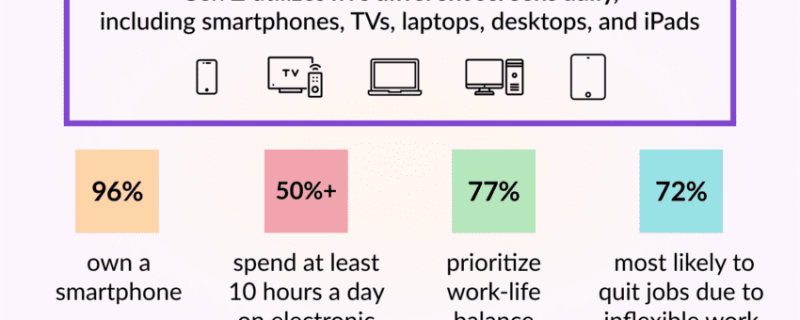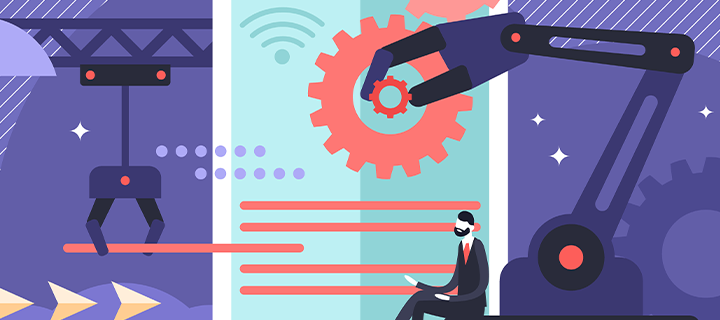Gen Z And Return To Office

The Return to Office mandate has been a challenge for so many workers, from navigating a long commute to finding affordable child care and managing family schedules. However, there’s a generation that started their career at the beginning of the pandemic and may only know work life as remote employees. For Gen Z and even younger Millennials, the return to office can be overwhelming. They may struggle with the cultural shift and find it difficult to adjust to office life norms that many of us take for granted. And it’s an issue that can’t be ignored in the hopes that younger workers will just “adjust”. By 2030, Gen Z is projected to make up about a third of the workforce and their needs and influence will only continue to impact the office.
Why is Gen Z struggling with returning to the office? After all, we’ve read reports that many of them feel lonely and isolated working remotely and crave in-person contact. Let’s take a look at 4 top challenges they’re facing:
- They’ve never experienced office norms. From in-person meetings to casual chats while getting a cup of coffee, this is all new to many younger workers. This also includes things that are often learned through direct experience (aka, the hidden language of the office), such as:
- Reading the tone of meetings and knowing how (and when) to speak up in groups
- How to deal with making mistakes and take accountability
- How to build visibility at work
- They’re used to autonomy: Working remotely forced many early-career employees to be self-starters and find their work rhythm and direction without a lot of external help or validation. Now, being watched and interrupted can feel distracting and even undermining. They may feel like they’re not trusted and start to become disengaged with the workplace.
- They’re feeling overwhelmed and overstimulated in the office: For a generation used to remote work, office life presents a whole new set of sensory overload: constant noise, lack of space, social anxiety. This can quickly lead to fatigue, a loss in productivity and burnout.
- They feel like they might be “misunderstood”: In a remote setting, the work spoke for itself. Now, it’s not just about productivity, but there’s pressure on younger workers to present themselves in a certain way. This can cause anxiety about being perceived as “antisocial”, “awkward” or “checked out”. They may fear that this could impact their career advancement.
If you’re struggling with the challenges of returning to the office full time and the stresses of life in general right now, working with a coach, like Leah M Joppy and Associates, can help. Coaching can provide a fresh perspective, goal setting and strategies to make this major life transition a little easier to handle. For managers, we can help you learn the most effective ways for managing the growing number of younger workers and dealing with the challenges they’re experiencing in the office.
To learn more, call us at 301-670-0051 or email us at leah@lmja.com.
Managing The Stress Of In-person Work

The transition back to in-office work brings a unique set of challenges, especially for those who experienced a long period of remote work. The shift to an in-person work environment can feel overwhelming, whether it’s adjusting to new routines, balancing work with life or dealing with the emotional impact of change. The first step in managing this stress is acknowledging how you’re feeling. Maybe you’re angry and resentful or maybe you feel a sense of sadness each morning. Identifying your emotions can help you better understand and address the sources of stress. Let’s look at 3 other practical ways to help manage the challenges of returning onsite:
- Create a Healthy Work-Life Balance: One of the biggest stressors of returning to in-office work is maintaining a healthy work-life balance. A few ways to help include: setting clear boundaries for when your workday starts and ends; resisting the urge to check emails or work after hours; and making time for family, hobbies and relaxation a priority that’s non-negotiable. The return to commuting can also really eat into your time, but try your best to use your commute to decompress. Use this time to listen to music, a podcast or reach out to a friend or loved one.
- Reframe the Transition as an Opportunity: Instead of focusing completely on the challenges, try to view your return to the office as chance for growth and new opportunities. Reframing the situation can help shift your mindset, making the transition feel less stressful. Think about how reconnecting with co-workers can offer a sense of camaraderie and collaboration opportunities that might have been missing during remote work. Many people find they are more productive in an office environment, with fewer distractions. Also, being physically present in the office may offer more professional opportunities, enabling you to take part in impromptu discussions and engage with leadership in a way that might be harder virtually.
- Focus on What You Can Control: Returning to the office may have come with a slew of new guidelines and expectations. Some of these changes may be beyond your control. However, focusing on the aspects of your workday that you can control helps reduce stress. For example, be honest with your manager about your needs and concerns. Open communication can help you navigate any adjustments and get the support you need. Now is also the time to stay organized and maintain a schedule to track to-do lists, deadlines and meetings. It’s an effective and simple way to feel more in control of your day.
Returning to the office full time is a big change and it’s natural to feel stressed, sad or even angry. However, with the right mindset and tools, you can ease the transition and manage the challenges that come with it. Leah M Joppy and Associates can work with you to face these challenges head-on. We can help you focus on building a new routine, maintain balance and take care of your mental and physical health. We can also provide tailored workshops to help team members adjust to their new norm. Learn more by calling us at 301-670-0051 or email us at leah@lmja.com.
The Challenges Of Returning To Office

While chaos, layoffs and agency restructuring have dominated the headlines for months, there is a new day-to-day reality for many federal workers: the return to the office. It’s a reversal of the remote work schedule so many of us had become accustomed to. Where we once established a greater work/life balance, enjoyed a more flexible schedule and often had better focus, we’re now dealing with long commutes, cramped workspaces and shaky internet. It’s been a challenging time for so many and an upheaval in our routines and schedules. What are some of the biggest challenges that workers are experiencing? Here’s a look at some of the top areas:
- Challenges for working mothers: According to the Institute for Women’s Policy Research, 60% of women say job flexibility is a deciding factor in accepting employment. For many working mothers, the ability to work remotely at least a few days a week isn’t just a luxury, it’s essential. If flexibility is taken off the table, many women will choose to resign or look elsewhere for organizations that offer a better work/life balance. Federal data shows that women account for about 45% of the government workforce, far below the public sector’s 58%. The federal government could see a mass exit of experienced female professionals if this lack of flexibility continues.
- Challenges With Technology: A lot of remote workers felt their set up at home was better than what they had in the office. And many wonder why they need to be onsite for the same virtual meetings they were having at home, only with a more challenging internet connection. Remote work forced the widespread adoption of digital tools and technology to make communication, collaboration and productivity easier. Returning to the office can be challenging for employees who have become used to remote-friendly workflow and technology, particularly if they were onboarded as remote workers.
- Challenges With Office Culture: For some employees, going back to the office means a return to traditional office culture, stricter schedules and less autonomy. This may be a big shift from the more relaxed culture enjoyed during remote work.
- Challenges With Expenses: Working remotely saved many employees a lot of money, whether it was saving on commuting expenses to not having to spend as much money on lunches and a work wardrobe. Childcare and caregiving costs for aging parents can also be incredibly costly and a major source of stress for many workers.
At least some of these challenges probably sound familiar. And, unfortunately, many of them can’t be controlled. We can’t change the traffic on the Beltway or the crowds on the Metro. What we can do is focus on what we can control: how we react to situations, how we take care of ourselves and establishing new routines. We’ll cover that a little more in our next article.
It’s easy to write about these challenges. It’s harder to figure out how to handle them – either individually or as a group. If you’re struggling with the challenges of returning to the office full time and the stresses of life in general right now, working with a coach, like Leah M Joppy and Associates, can help. Coaching can provide a fresh perspective, goal setting and strategies to move from merely surviving to thriving. And not only can we help with coaching but we can also provide tailored workshops to help team members adjust to their new norm. Give us a call.
To learn more, call us at 301-670-0051 or email us at leah@lmja.com.
The Impact Of Change On Our Personalities

Change and uncertainty. These two words have been constants in our professional lives for the past few months. Everyday seems to bring new questions, messages and expectations. It’s stressful, to say the least, when it feels like our world is being turned upside down. Change, at its core, is difficult for people to deal with, particularly when it’s not by choice. It challenges our sense of control, awakens our fear of the unknown and can compromise our values and principles.
Why is change and uncertainty so hard for us? The short answer is that it’s the way our brains are hardwired. We crave what feels comfortable and a shake up to our routine can leave us feeling rattled. It’s all perfectly normal. Let’s take a closer look at why we’re resistant to change on a neurological and psychological level. Think about each of these factors and how change is causing stress in your life. By acknowledging them and observing them carefully, you can help to reduce their impact.
The impact of change on our neurological needs:
- The need for certainty (for example, “I don’t know what to expect.”) Our brains respond to information and react to a lack of information as a threat.
- The need for processing our thoughts (for example, “I haven’t had chance to think about what’s going on.”) When presented with surprising or shocking information, our fight-or-flight instinct narrows our focus onto that information and excludes other things going on in our lives.
- The need for routine (for example, “This is how I’ve always done things.”) We’re creatures of habit and we’re comfortable with routines. Change rocks our sense of security and makes us feel vulnerable and out of control.
The impact of change on our psychological needs:
- The need for self-esteem (for example, “Am I good enough?”) Our past successes play a big role in our self-esteem. When we’re forced to deal with change, it can sometimes feel like these successes are being undermined.
- The need for confidence (for example, “I’m afraid I’ll fail.”) We want to feel certain that we’ll be able to achieve success no matter what the future holds. Our uncertainty can cause us to feel isolated and withdrawn in a time when we need support and community the most.
- The need for control (for example, “Do I have a choice?”) This is a big one right now. We want to make decisions on our terms and feel like we’re in control of our choices. Change is particularly hard when it’s not according to our design.
Change is always going to happen, but how we deal with it is crucial. Our level of resilience (the ability to “bounce back”) is a crucial component for both physical and emotional wellbeing. Fortunately, resilience is a skill that can be developed and strengthened over time. That’s where coaching comes in! Working with a coach, like Leah M Joppy and Associates, provides a fresh perspective, goal setting and accountability to achieve powerful results. Our course, Building Resilience In Times Of Uncertainty, includes a resilience assessment and provides feedback about resiliency levels in 3 key areas: Challenge, Control and Commitment. Participants learn how to better prepare and manage uncertainty in life. And in a professional world filled with change, it can mean the difference between surviving and thriving. Our second course, What’s Next? Purposeful Planning for Post Retirement,will assist you in developing a proactive plan for a meaningful post-retirement life, grounded in your values, strengths, and experiences.
To learn more, call us at 301-670-0051 or email us at leah@lmja.com.
Helpful Tips On How To Deal With Change

Change and uncertainty in our lives can cause a roller coaster of emotions: fear, anger and sadness, just to name a few. Viewing change as an opportunity can feel impossible when it seems like it’s coming at us from all directions. We can’t stop life’s ebbs and flows, but we can learn how to accept change and even view it as an opportunity. It’s all about how we frame it.
Small adjustments to your mindset and habits can help with resistance to change and dealing with the uncertainty that comes with it. Here are 3 suggestions to get started:
Write down your thoughts: When faced with change, it’s natural for your mind to be flooded with worry, conflicting emotions and ‘what-if; scenarios. Journaling can be a powerful way to understand your feelings, discover self-limiting beliefs and find clarity. Whether you want to write down your emotions, describe your doubts or jot down questions, it’s important to get it all out on paper. Once you’ve written it all down, you can look for patterns or mental blocks you want to work on.
Lean on your support network: Change can feel particularly scary when you feel like you’re going through it alone. Being a part of a supportive social network can reduce stress and improve well-being. Sharing your experiences with your community and listening to the experiences of others can help you feel less isolated and more encouraged to face what’s next.
Accept your fears and don’t be ashamed of them: For most people, fear doesn’t feel good. However, you can fight off many fears by fostering a positive mindset and practicing a few simple thought exercises such as: concentrating on the strengths and accomplishments that have brought you this far; thinking about all of the challenges you’ve overcome and how you worked through them; identifying the root cause of your fear to avoid creating a self-fulfilling prophecy.
Another exercise is to focus on what you can control. Adopting practices that help you connect with and regulate your emotional state (ie: a meditation routine) help develop a deeper sense of strength and resilience. When the next change happens, you’re more likely to see it as an opportunity for growth, learning and for trying something different.
Life has few guarantees, but one thing you can count on is change. Building resilience can be your secret weapon for success and helps you thrive in the face of adversity. With all the changes and uncertainty that 2025 has brought so far, Leah M Joppy and Associates is ready to help you enhance your resiliency skills and face change with confidence. Our course, Building Resilience In Times Of Uncertainty, includes a resilience assessment and provides feedback about resiliency levels in 3 key areas: Challenge, Control and Commitment. Participants learn how to better prepare and manage uncertainty in life. And in a professional world filled with change, it can mean the difference between surviving and thriving. Our second course, What’s Next? Purposeful Planning for Post Retirement,will assist you in developing a proactive plan for a meaningful post-retirement life, grounded in your values, strengths, and experiences.
To learn more, call us at 301-670-0051 or email us at leah@lmja.com.
Dealing With Change. Calling On Our Resilience.

“Change is the only constant in life.” You may not have known that this quote originated from Greek philosopher, Heraclitus, but we bet you’ve heard it a time or two! With the start of a New Year, a change in administration and so many other upcoming events, many of us are feeling the uncertainty (and stress!) of change in our professional and personal life.
Change is always going to happen, but how we deal with it is crucial. It’s about our level of resilience, otherwise known as the ability to tolerate difficult or stressful situations while still remaining positive and productive. Some call it the ability to “bounce back.” According to the APA Dictionary of Psychology: ‘Resilience is the process and outcome of successfully adapting to difficult or challenging life experiences, especially through mental and behavioral flexibility and adjustment to both external and internal demands.’ It’s a crucial component for your physical and emotional wellbeing and can mean the difference between surviving and thriving.
Embrace the 7 C’s. Understanding and embodying the 7 C’s of resilience can transform how you approach both your professional and personal life. It enables you to navigate obstacles with strength and confidence. Although initially directed at childhood development, Dr. Kenneth Ginsberg’s 7 Cs of resilience are vital in today’s ever-changing workplace. Let’s break it down:
- Competence: Develop the skills and knowledge to handle workplace situations effectively.
- Confidence: Build the self-confidence to trust your abilities and judgment in challenging situations.
- Connection: Foster strong relationships with team members to creative a supportive, collaborative environment.
- Character: Cultivate your personal values and integrity to guide your behavior and decision-making process.
- Contribution: Feeling that your contributions matter in order to build a sense of purpose and value.
- Coping: Develop effective ways to manage stress and adversity. This includes building problem solving and emotional regulation skills.
- Control: Focus on the parts of work you can control (i.e., your decisions and reactions) and let the rest go.
We can help. It sounds like a lot, especially when you feel like you’re just trying to stay afloat and manage your day-to-day tasks. But you don’t have to go it alone. Our new course, Building Resilience In Times Of Uncertainty, focuses on how to manage the stress, anxiety and uncertainty of “what’s next.” This course includes a resilience assessment and provides feedback about resiliency levels in 3 key areas: Challenge, Control and Commitment. Participants learn how to increase their resiliency and better prepare and manage uncertainty in their career and personal life. And who doesn’t want that, especially in today’s world?
Call us at 301-670-0051 or email us at leah@lmja.com for more information.
Effective Strategies For Building Your Resilience

Many of us work in constantly connected, ‘always-on’, highly demanding positions where stress and the risk of burnout are common. Add to that the changes of an upcoming administration and it can seem like it’s almost too much to deal with. Since the pace and intensity of our work culture aren’t likely to change anytime soon, it’s more important than ever to build resilience skills to navigate work life. As we discussed in our previous article, resilience is the ability to ‘bounce back’ from challenges and adversity. It can have a major impact on your stress level, mental well-being and overall job satisfaction.
The good news: resilience is a skill that can be developed and strengthened over time. The key is to get started! Here are 7 effective strategies to help foster a positive mindset, manage stress and ultimately develop more resilience:
- A study from NIH found that people are 3.5 times more likely to be resilient when in good physical health. Prioritizing sleep, exercise and proper nutrition is essential, particularly during times of change. Physical health supports resilience and resilience also leads to better physical recovery.
- Develop a daily routine. Developing consistent habits, no matter how small, can help you make meaningful progress. Build some coping mechanism exercises into your routine, such as breathing and relaxation exercises and a mindfulness practice to better deal with stressful situations.
- Focus on what you can control: Discerning what you can and can’t control keeps you positive and motivated. It’s also important to not ruminate on the past and focus on what lies ahead.
- Don’t focus on your weaknesses. Focusing on your strengths helps you grow much faster than trying to improve your weaknesses. As hard as it is, try to see failure as an opportunity. With the right mindset, it can actually be a catalyst for growth.
- Build a support network. Connect with co-workers, mentors or friends who can offer encouragement and advice during challenging times.
- Don’t dwell in self-pity. We all know firsthand that life can be hard, but dwelling on our circumstances keeps us from emerging from them and moving forward.
- Don’t compare yourself to others. Define your own version of success that has nothing to do with others’ strengths and accomplishments.
Resilience is not just about surviving, but thriving in the face of adversity. And it can be your secret weapon for success. Leah M Joppy and Associates is ready to make 2025 the year you enhance your resiliency skills and face changes and challenges with confidence. Our course, Building Resiliency In Times Of Uncertainty, includes a resilience assessment and offers feedback about resiliency levels in 3 key areas: Challenge, Control and Commitment. This course will help participants identify strategies to increase their resilience and help manage the uncertainty of what’s next.
Call us at 301-670-0051 or email us at leah@lmja.com for more information. Learning to manage workplace change – a critical strategy for the new year!
Why Some Managers Are Resistant To Work Schedule Flexibility

For many organizations, work schedule flexibility is a new part of their compensation package. It’s a powerful tool in terms of employee engagement, retention and recruiting. Remote and flexible schedules have shown to not only provide employees with higher job satisfaction, but better health, less absenteeism, increased work-life balance and less stress. This is all well and good for workers, but what do managers really think about remote work? While many understand the appeal and benefits, it’s still difficult to embrace change and work through the challenges of managing a remote and/or hybrid team.
Here’s a look at 7 reasons why managers may be resistant to remote work:
- Lack of accountability and supervision: Sure, some team members work well (and in some cases better) working remotely. Then there are those that struggle with time management, distractions and other challenges. Managers may feel that it’s more challenging to supervise employees and keep them accountable when they’re not physically present in the office.
- Loss of collaboration: Face-to-face interaction is often believed to foster a more cohesive work environment. Some managers worry that remote work can make it harder for team members to truly feel like a team. This is of particular concern for new team members and younger workers who are just starting out in their career.
- Lack of company culture: Strong in-office culture can be a key component for an organization’s retention and recruitment. Managers may worry that remote work could be a hinderance towards building this culture.
- Increase in security concerns: There may be concerns about the security of data when employees are working outside the office.
- Decrease in productivity: Some managers may feel that team members are more productive in a controlled office environment. Working from home can potentially have more distractions and chances to break from a traditional work schedule.
- Concerns about equity: In some settings, not all roles can be performed remotely or on a hybrid schedule. Allowing some employees to work from home might create perceived (or actual) inequities among team members.
- Holding onto a traditional mindset: Some managers may still have a traditional view of work that involves all team members being present at a common workplace. Change is hard and personal experiences and beliefs take time to overcome, particularly when it comes to management practices.
As we discussed last month, an annual government-wide survey conducted by the Office of Personnel Management found that more than two-thirds of federal employees are still teleworking at least occasionally. Remote and hybrid work isn’t going anywhere, but neither are the management challenges if your organization doesn’t face them head on. Leah M Joppy and Associates can help you figure out your primary challenges and work with you and your team to make remote/hybrid working a more efficient, productive and collaborative experience!
Call us at 301-670-0051 or email us at leah@lmja.com to learn more.
The Government and Artificial Intelligence

Conversations about Artificial Intelligence (AI) have been going on everywhere over the past year. The capabilities of ChatGPT, the generative AI chatbot developed by OpenAI, have gone viral across social media and we’ve marveled as it answered complex questions in seconds with shocking accuracy. But as AI has seemingly blown up and commanded our attention, it also poses as many questions as it answers. How will it impact the future of the workplace? And what will jobs look like moving forward?
A new report from Fedscoop.com, “Gauging the Impact of Generative AI on Government,” surveyed 200 government program and operations executives, as well as IT and security officials. The report identified the major issues and concerns executives face as they consider adopting generative AI in their agencies. It found that three-fourths of the leaders polled said that their agencies have already begun establishing teams to assess the impact of generative AI and are planning to implement initial applications in the months ahead. And according to a new database uploaded to the AI.gov website, the government recently disclosed more than 700 artificial intelligence use cases among federal agencies.
Let’s take a closer look at some of the numbers from this survey, as they provide interesting insight into how agency leaders view the future of AI:
- Survey respondents feel generative AI will provide major opportunities for employees. The top opportunities include:
- Ability to give employees added technical support (eg: a co-pilot): 65%
- Ability to reduce the time required to complete work processes: 64%
- Ability to free up employee tasks to produce more valuable work: 63%
- Nearly half of the agency business executives polled expect one or more generative AI applications will be rolled out in the next 6-12 months for data analytics, IT development/cybersecurity and business operations. IT executives are more confident in the timeline: roughly two-thirds believe it will happen within the next 6-12 months.
- A significant percentage of leaders (71%) believe that the potential advantages of using generative AI in their agency’s operations outweigh the perceived risks.
- Half of all executives polled (and 64% of those at defense and intelligence agencies) cited a lack of employee training to use generative AI responsibly as a top concern. However, only 32% noted the need to develop employee training programs as a critical employee concern. This suggests a big disconnect in how agency leaders view AI training.
We’re all at the beginning of a journey to understand generative AI’s power and capabilities. Research suggests that this new era of AI will transform roles and increase performance across areas such as customer interactions, data analysis and software development. However, the roll-out and implementation of AI is only as good as the communication by leaders and the training of workers. Most of all, it calls for careful planning. Call us at 301-670-0051 or email us at leah@lmja.com for more information.
The Pros and Cons of AI in the Workplace

Generative artificial intelligence (AI) has become a polarizing topic in recent months. The rapid evolution of ChatGPT and its capabilities have captured the world’s attention and have prompted questions about its impact on our lives, particularly our work lives. As with all new waves of technological advances, there are concerns: “Will AI replace my job?” “What are the ethical considerations?” “How do I even begin to learn about this stuff?”
As we saw in our article above, agencies are generally in favor of adopting AI in the workplace and some implementation has already started (or is on the horizon). While change can be challenging, it’s on the way, whether we’re ready or not. Now’s the time to start looking at the pros and cons of AI in the workplace and having discussions about how it could impact our work lives moving forward. Some of the top pros and cons are outlined below:
AI Pros in the Workplace
- Increased Efficiency: AI can automate many routine tasks, freeing up workers to focus on higher-level projects and increase productivity.
- Enhanced Decision-Making: AI can analyze data and offer insights that people may not be able to identify, leading to better decision-making and effective strategies.
- Cost Savings: By automating tasks, AI can reduce labor costs and improve the bottom line for organizations.
- Enhanced Customer Experience: AI-powered chatbots and other tools can provide fast, personalized service to clients, improving their overall experience.
AI Cons in the Workplace
- Job Displacement and Challenges in the Workforce: This is probably the biggest one. As AI automates routine tasks, there is a concern that certain job roles may become obsolete, leading to unemployment. The need to reskill employees to adapt to changes brought by AI poses a number of challenges for workers and organizations.
- Ethical Considerations: AI raises ethical concerns regarding data privacy, bias and transparency. Organizations must be proactive in addressing these concerns and establish ethical guidelines to prevent misuse or unintended consequences.
- Lack of Training and Poor Implementation: Implementing AI requires major investments in infrastructure, training and integration with existing systems. Cutting corners in areas like training as a way to save money results in misuse or not using AI to its fullest potential.
- Lack of Emotional Intelligence: While AI is great at data analysis and automation, it lacks the human touch needed for certain tasks. Industries relying heavily on human interaction may find it challenging to replace human expertise with AI systems.
- Accuracy: AI has developed at a rapid pace and it still has a way to go to offer up-to-date information. Tools such as ChatGPT base decisions on the past and it’s been argued that it can be behind with it comes to accurate facts and updates. It’s still important to do your own research to ensure the information is correct.
As agencies start to integrate generative AI into their operations, understanding opportunities and concerns becomes crucial for preparing to transition into this AI-driven era of government. Most of all, it calls for careful planning. Call us at 301-670-0051 or email us at leah@lmja.com for more information.